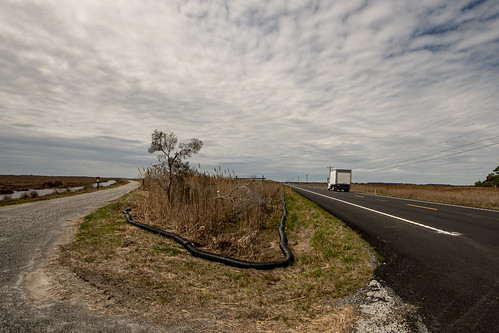
Carrie Samis
Wild turtles are on the move in spring and summer, looking for love and a place to nest. During nesting season female turtles don’t travel far from their typical homes, often at-tempting to cross busy roads to reach ideal nesting habitat. Deal Island Road in the Deal Island Wildlife Management Area (WMA) is one such location, and local residents have expressed concern about multiple occurrences of turtle mortality on the road.
Carrie Samis, a Princess Anne resident whose parents live on Deal Island, contacted the Maryland Department of Natural Resources (DNR); responding was wildlife ecologist Scott Smith, who agreed to survey the area. He determined that the road berm is one of the few “high and dry” habitats around, naturally attracting females of all turtle species to nest–primarily diamondback terrapins, but also other species including the eastern mud turtle, common snapping turtle, eastern painted turtle, and spotted turtle.
“The roadway itself is a barrier to free movement across the marsh, so any species wishing to get from point A to point B when those points are on opposite sides have to cross the road,” Smith says.

Smith and his colleagues at DNR researched solutions to the issue and determined that creating a barrier along the road berm would be the most effective solution for the near-term. The length and location of the barrier was chosen based on the distance of the area along Deal Island Road with the greatest observed turtle roadkill–the entrance road to the Wildlife Management Area and the Dames Quarter Bridge.
 In conservation partnership with DNR, the State Highway Administration purchased the materials for the barrier and completed the installation starting east of the Wildlife Management Area, extending to the bridge at Dames Quarter Creek. The team installed 12,600 linear feet of 6-inch polyethylene perforated drain pipe, creating a 6,300-foot roadway barrier that turtles cannot traverse. The barrier was affixed to the road berm with about 2,000 U-shaped rebar anchors roughly every 6 feet, to prevent turtles from burrowing underneath and through the barrier. Work was originally supposed to have been completed a year ago but pandemic-related supply chain issues made the products unavailable.
In conservation partnership with DNR, the State Highway Administration purchased the materials for the barrier and completed the installation starting east of the Wildlife Management Area, extending to the bridge at Dames Quarter Creek. The team installed 12,600 linear feet of 6-inch polyethylene perforated drain pipe, creating a 6,300-foot roadway barrier that turtles cannot traverse. The barrier was affixed to the road berm with about 2,000 U-shaped rebar anchors roughly every 6 feet, to prevent turtles from burrowing underneath and through the barrier. Work was originally supposed to have been completed a year ago but pandemic-related supply chain issues made the products unavailable.DNR staff note this is a conservation experiment; the area will be monitored for its success and the results used to guide the construction of additional wildlife crossing solutions. In the future, DNR would like to create breaks in the road to allow animals to freely move across the marsh.
“Ideally, the roadway would be linked by small bridges or bisected with turtle tunnels,” says Smith. “However, that is a more expensive, longer-term solution. The current barrier was comparatively inexpensive and quicker to complete.”
Even with the added construction of bridges or turtle tunnels there would still be a need for barriers along the road berm to deter wildlife from crossing busy roads. For now, the diamondback terrapin–Maryland’s state reptile–and its brethren will find safe passage to nest along Deal Island Road.
dnr.maryland.gov/wildlife
Megan McGinn-Meals is a Public Information Officer in the department’s Office of Communications. Article appears in Vol. 25, No. 3 of the Maryland Natural Resource magazine.
